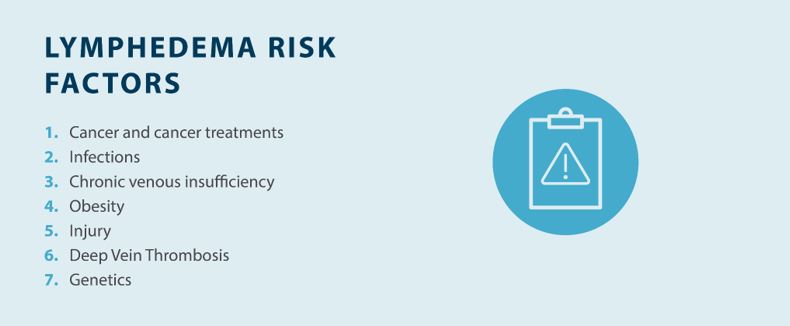Lymphedema and Weight Loss
Living with lymphedema while trying to manage your weight can feel overwhelming, but understanding the connection between lymphedema and weight loss can help you develop effective strategies for both conditions.
Read More

Lymphedema is swelling caused by lymphatic dysfunction that leads to a backup in the lymphatic system, resulting in chronic swelling. Preventing and managing the swelling caused by lymphedema starts with understanding the causes and risk factors. There are several potential causes of lymphedema — from acute injuries to genetics. Various medical conditions can also put you at higher risk for lymphedema. You can learn about some of the top risk factors for lymphedema below.
1. Cancer and Cancer Treatments
2. Infections
3. Chronic Venous Insufficiency
4. Obesity
5. Infections and Injury
6. Deep Vein Thrombosis
7. Genetics
How Can You Reduce Your Risk of Lymphedema?
Wrapping Up: Lymphedema Risk Factors

There’s a strong link between lymphedema and cancer. Cancer that affects the lymph nodes can create a disruption in your lymphatic system. Various types of cancers can spread to your lymph nodes over time, such as breast or pelvic cancer.
Radiation therapy and cancer surgery can also damage your lymphatic system and cause a disruption. Lymph nodes may be removed during cancer treatment, and radiation therapy is commonly used to treat cancer. If you’re undergoing cancer surgery or radiation therapy, ask your oncologist about your risk of developing lymphedema.
Infections can cause damage to several parts of your body, including your lymphatic system. Infections and lymphedema are closely related, as the lymphatic system plays an integral role in immunity to help protect your body again viruses and bacteria. However, certain types of infections can be especially dangerous to the lymphatics and cause damage over time.
Cellulitis is a type of bacterial infection that affects the deeper layers of your skin, typically through a cut or wound. These infections are common in the arms and legs, but they can occur anywhere. Cellulitis can progress from the deep layers of your skin to your muscle tissue, bloodstream, and lymphatic system if you don’t have it treated. This damage to the tissues and lymphatic system caused by cellulitis can lead to or exacerbate symptoms of lymphedema.
Individuals with lymphedema are more susceptible to infection, so preventing and properly treating wounds is crucial. If you have a cut or burn, you should treat it to avoid infection. For more severe cuts and injuries, seek necessary medical attention to get assessed and treated by a professional.
Chronic venous insufficiency (CVI) is a medical condition that affects the valves inside your veins. These valves help blood flow against the force of gravity, moving it from your lower extremities back to your heart. People with CVI have malfunctioning valves that can’t properly transport blood back to the heart, causing blood to pool in the lower extremities as a result of gravity.1
The poor circulation that results from the body’s inability to efficiently return blood to the heart, blood can buildup in the veins, causing increased pressure in the lower extremities. Over time, this increased pressure and inflammation can compromise the lymphatic system, leading to lymphedema. Additionally, the increased pressure that results from impaired venous circulation can cause blood plasma and proteins to leak into the surrounding tissues, overwhelming the lymphatic system’s ability to drain this excess fluid.2 Overall, if you’re an individual living with CVI, it’s important to monitor your symptoms and work with your healthcare provider to manage your condition to reduce the risk of lymphedema.
Obesity is one of the more common lymphedema risk factors because it puts added stress on your circulatory and lymphatic systems. Being overweight or obese can increase your risk of developing several medical conditions, which is why it’s vital to maintain a healthy weight. The link between lymphedema and obesity makes weight management especially important for lymphedema patients.3
Diet and exercise are effective ways to manage and maintain a healthy weight. Working with a nutritionist and personal trainer can support you in developing a lymphedema diet and exercise weight to support you in reaching a healthy weight. Other dietary changes may include reducing your salt intake, and avoiding alcohol and caffeine. Make sure you talk to your doctor or lymphedema specialist to learn more about eating a healthy diet and safe lymphedema exercises.
Certain types of injuries can also be a risk factor for developing lymphedema. Because infections are a lymphedema risk factor, the injuries that cause infections like cellulitis can put you at risk. Any infection that penetrates the surface layer of the skin may cause damage to your lymphatic system and increase the risk of developing or worsening lymphedema symptoms. Some common examples include burns and cuts that affect the skin layers.
Lymphedema can also be caused by acute injuries that damage your lymphatic system directly. Burns, blunt force, or crushing injuries, such as those sustained from car accidents or traumatic injuries, can damage your lymphatic system.
People with lymphedema are also more susceptible to certain injuries, and those injuries can make swelling and other symptoms worse. If you’ve recently been diagnosed with lymphedema, you can talk to your doctor or specialist to learn more about your injury risk with lymphedema.
Deep vein thrombosis (DVT) is also known as a blood clot. These clots occur in the deeper veins that play an essential role in your circulatory system. DVT can be life-threatening in some cases, so you should always visit a doctor if you experience symptoms like acute onset of swelling, redness, skin discoloration, or pain in a leg.
DVT can cause lymphedema because of the damage it can cause to your venous system, which can then overload the lymphatic system, preventing it from efficiently processing fluids. Common causes of blood clots include genetics, obesity, sedentary lifestyles, smoking, and surgery.4
Lymphedema can be a result of a hereditary lymphatic disorder, known as primary lymphedema, resulting in the malformation of the lymphatics. Primary lymphedema can be congenital — which means it’s present at birth — or it can develop later in life. There are different categories of lymphedema based on your age when symptoms start.
Although the exact cause of genetic lymphedema is unknown, a mutation in the FOXC2 gene is thought to be one of the lymphedema risk factors for those who develop lymphedema during or after puberty.5
While lymphedema can be hereditary, it’s not nearly as common as secondary lymphedema. Most patients who have lymphedema develop it as a result of CVI, cancer, cancer treatment, infection, injury, or another risk factor.
Lymphedema can’t always be avoided, especially if you have a genetic lymphatic disorder. While there are steps you can take to reduce your risk of developing lymphedema, there are several potential causes that you can’t always avoid. Instead, lymphedema patients should focus on managing symptoms and preventing complications to improve their quality of life. Here are some of the common lymphedema treatment and management methods:

There are several lymphedema risk factors, especially when it comes to secondary lymphedema. If you have cancer or recently underwent cancer surgery or radiation therapy, you can talk to your oncologist to learn about lymphedema. Working with a lymphedema specialist can help you manage your symptoms and avoid more severe complications.
Compression is important when it comes to treating lymphedema. The Flexitouch Plus System and Nimbl System from Tactile Medical use pneumatic compression to provide relief from lymphedema swelling. Contact us or talk to your doctor to learn more about our pneumatic compression devices today.
References
1. Risk Factors for Chronic Venous Disease. National Library of Medicine. Accessed September 10, 2023
https://www.ncbi.nlm.nih.gov/pmc/articles/PMC2023874/
2. Spiridon M, Corduneanu D. Chronic Venous Insufficiency: a Frequently Underdiagnosed and Undertreated Pathology. Maedica (Bucur). 2017 Jan;12(1):59-61. https://www.ncbi.nlm.nih.gov/pmc/articles/PMC5574075/
3. Obesity-induced Lymphedema Following Massive Weight Loss. National Library of Medicine. Accessed September 10, 2023
https://www.ncbi.nlm.nih.gov/pmc/articles/PMC4494496/
4. Deep Vein Thrombosis (DVT). Penn Medicine. Accessed September 10, 2023. https://www.pennmedicine.org/for-patients-and-visitors/patient-information/conditions-treated-a-to-z/deep-vein-thrombosis
5. FOXC2 disease-mutations identified in lymphedema-distichiasis patients cause both loss and gain of protein function, National Library of Medicine, Accessed September 10, 2023
https://www.ncbi.nlm.nih.gov/pmc/articles/PMC5342337/
Living with lymphedema while trying to manage your weight can feel overwhelming, but understanding the connection between lymphedema and weight loss can help you develop effective strategies for both conditions.
Read More
Stage three lymphedema is the most advanced stage of this chronic condition. In this stage, the affected body part might display one or more symptoms, such as significant swelling, alterations in the skin, or recurring episodes of infection. While this stage can be challenging to manage, understanding your condition and...
Read More
When the lymphatic system becomes compromised, fluid buildup can lead to stage 1 lymphedema, a condition marked by mild but noticeable swelling in affected areas. This initial stage is a crucial window for intervention, as proper treatment can prevent progression to more severe stages. Knowing the signs, causes, and treatment...
Read More
Living with stage 2 lymphedema brings unique challenges, but understanding your condition is the first step toward effectively managing it. While this stage marks a point where the condition becomes irreversible, there are many ways to maintain your quality of life and prevent symptoms from progressing. Keep reading to explore...
Read More
Call us at 1.800.575.1900